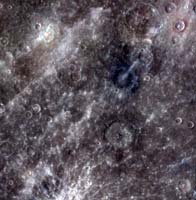|
COMETS EARTH JUPITER KUIPER BELT MARS MERCURY METEORITES NEPTUNE OORT CLOUD PLUTO SATURN SOLAR SYSTEM SPACE SUN URANUS VENUS ORDER PRINTS
PHOTO CATEGORIES SCIENCEVIEWS AMERICAN INDIAN AMPHIBIANS BIRDS BUGS FINE ART FOSSILS THE ISLANDS HISTORICAL PHOTOS MAMMALS OTHER PARKS PLANTS RELIGIOUS REPTILES SCIENCEVIEWS PRINTS
|
Related Documents
Download Options
Date acquired: March 29, 2011 Of Interest: The wide-angle camera (WAC) is not a typical color camera. It can image in 11 colors, ranging from 430 to 1020 nm wavelength (visible through near-infrared). It does this with a filter wheel: the 11 narrow-band filters (plus one clear filter) are mounted onto a wheel that can be rotated to allow the camera to capture an image through each filter. In this image the 1000 nm, 750 nm, and 430 nm filters are displayed in red, green, and blue, respectively. Several craters appear to have excavated compositionally distinct low-reflectance (brown-blue in this color scheme) material, and the bright rays of Hokusai crater to the north cross the image. During MESSENGERís orbital operations, we will typically use just eight of the WAC's filters. This decision was made to reduce the amount of data that must be stored on the spacecraftís solid-state recorder before the information can be downlinked. Itís also quicker than cycling through all 11 filters — the spacecraft is moving rapidly over the surface, and there isn't much time to image the same spot on the surface 11 times over before moving to the next area of interest. The sets of color images will help us learn about the variation in composition from place to place on the planet. For example, some minerals such as olivine and pyroxene often absorb more light at longer wavelengths than at shorter ones, so weíll be looking for their signatures in the reflectance spectra derived from each eight-color set. WAC images will be used in coordination with the Mercury Atmospheric and Surface Composition Spectrometer (MASCS), a hyperspectral instrument that provides reflectance information at many more wavelengths, but only for one spot on the surface at a time. On March 17, 2011 (March 18, 2011, UTC), MESSENGER became the first spacecraft ever to orbit the planet Mercury. The mission is currently in its commissioning phase, during which spacecraft and instrument performance are verified through a series of specially designed checkout activities. In the course of the one-year primary mission, the spacecraft's seven scientific instruments and radio science investigation will unravel the history and evolution of the Solar System's innermost planet. Credit: NASA/Johns Hopkins University Applied Physics Laboratory/Carnegie Institution of Washington |
